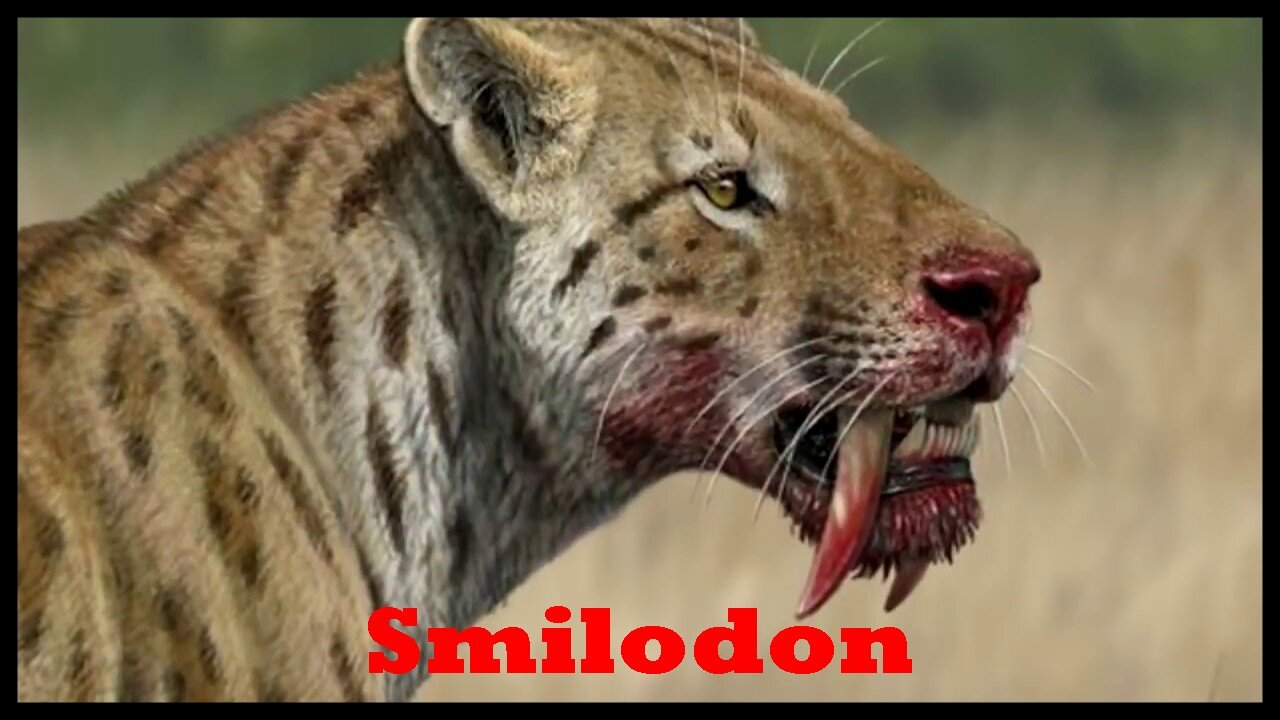Premium Only Content

Smilodon Dente-de-Sabre
Smilodon is a genus of the extinct machairodont subfamily of the felids. It is one of the most famous prehistoric mammals and the best known saber-toothed cat. Although commonly known as the saber-toothed tiger, it was not closely related to the tiger or other modern cats. Smilodon lived in the Americas during the Pleistocene epoch (2.5 mya – 10,000 years ago). The genus was named in 1842 based on fossils from Brazil; the generic name means "scalpel" or "two-edged knife" combined with "tooth". Three species are recognized today: S. gracilis, S. fatalis, and S. populator. The two latter species were probably descended from S. gracilis, which itself probably evolved from Megantereon. The hundreds of individuals obtained from the La Brea Tar Pits in Los Angeles constitute the largest collection of Smilodon fossils.
Overall, Smilodon was more robustly built than any extant cat, with particularly well-developed forelimbs and exceptionally long upper canine teeth. Its jaw had a bigger gape than that of modern cats, and its upper canines were slender and fragile, being adapted for precision killing. S. gracilis was the smallest species at 55 to 100 kg (120 to 220 lb) in weight. S. fatalis had a weight of 160 to 280 kg (350 to 620 lb) and height of 100 cm (39 in). Both of these species are mainly known from North America, but remains from South America have also been attributed to them. S. populator from South America was the largest species, at 220 to 436 kg (485 to 961 lb) in weight and 120 cm (47 in) in height, and was among the largest known felids. The coat pattern of Smilodon is unknown, but it has been artistically restored with plain or spotted patterns.
In North America, Smilodon hunted large herbivores such as bison and camels, and it remained successful even when encountering new prey species in South America. Smilodon is thought to have killed its prey by holding it still with its forelimbs and biting it, but it is unclear in what manner the bite itself was delivered. Scientists debate whether Smilodon had a social or a solitary lifestyle; analysis of modern predator behavior as well as of Smilodon's fossil remains could be construed to lend support to either view. Smilodon probably lived in closed habitats such as forests and bush, which would have provided cover for ambushing prey. Smilodon died out at the same time that most North and South American megafauna disappeared, about 10,000 years ago. Its reliance on large animals has been proposed as the cause of its extinction, along with climate change and competition with other species, but the exact cause is unknown.
-
 LIVE
LIVE
DeVory Darkins
42 minutes agoBREAKING: Charlotte Mayor dealt MAJOR BLOW after second train stabbing leaves victim hospitalized
6,419 watching -
 DVR
DVR
Timcast
1 hour agoShots Fired At Timcast Property, Country On Brink
57.2K30 -
 LIVE
LIVE
Dr Disrespect
1 hour ago🔴TARKOV LIVE - DR DISRESPECT - NO GEAR, NO FEAR
1,284 watching -
 LIVE
LIVE
Side Scrollers Podcast
2 hours agoRIP Blabs + Hasan ROASTED at Streamer Awards + Xbox HUMILIATED... Again + More | Side Scrollers
804 watching -
 UPCOMING
UPCOMING
Sean Unpaved
1 hour agoTime For Notre Dame To JOIN A CONFERENCE! | UNPAVED
16 -
 LIVE
LIVE
Steven Crowder
3 hours ago🔴 The Cinnabon N-Bomb: We Just Don't Care Anymore
24,153 watching -
 1:07:57
1:07:57
The Rubin Report
2 hours ago‘Shark Tank’ Legend Notices Something in Drug Boat Strike Others Are Unwilling to See
18.4K21 -
 LIVE
LIVE
LFA TV
16 hours agoLIVE & BREAKING NEWS! | MONDAY 12/08/25
3,935 watching -
 LIVE
LIVE
The Mel K Show
1 hour agoMORNINGS WITH MEL K - The Destruction of the Old Guard-The Chessboard has Flipped - 12-8-25
973 watching -
 1:01:05
1:01:05
VINCE
4 hours agoStop the Somali Steal | Episode 183 - 12/08/25 VINCE
196K133